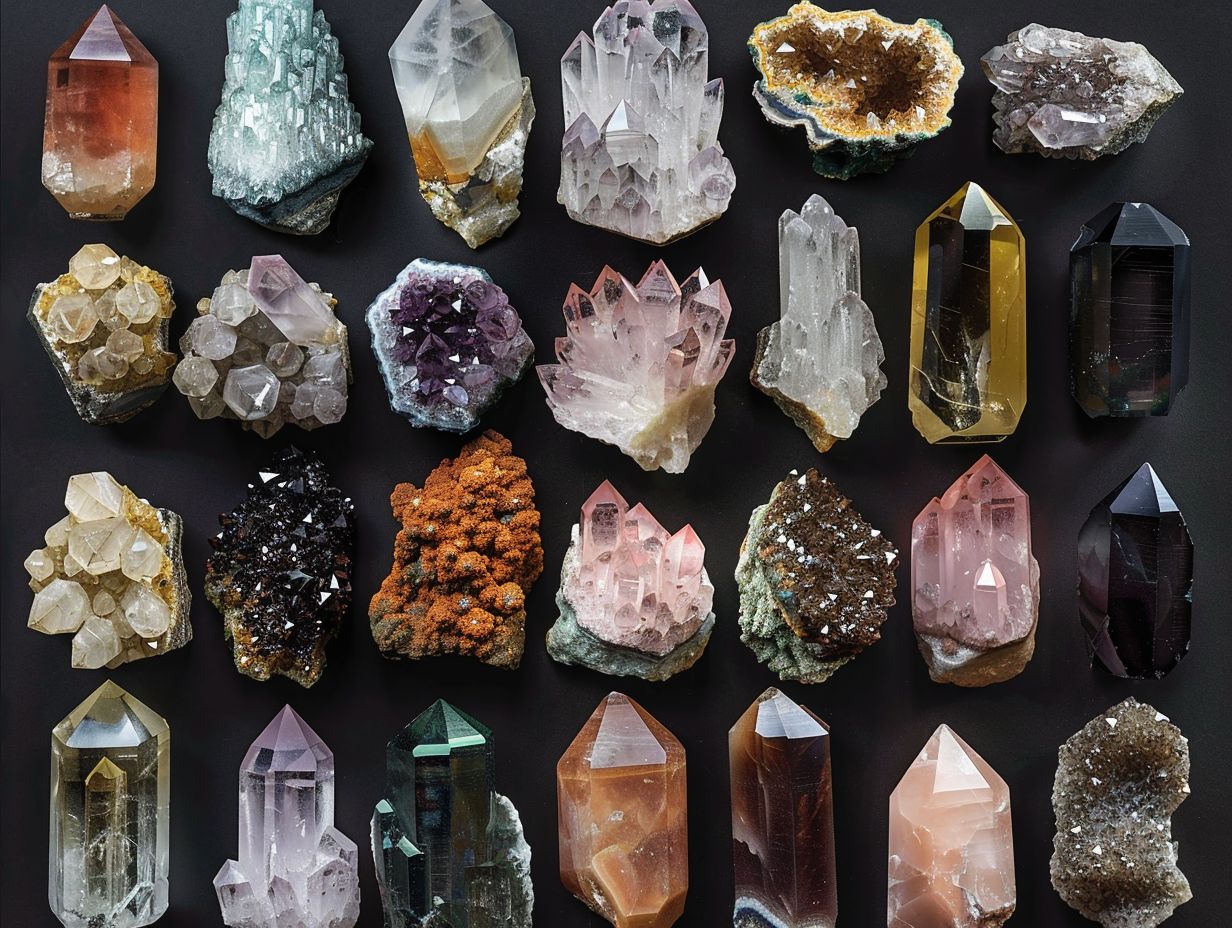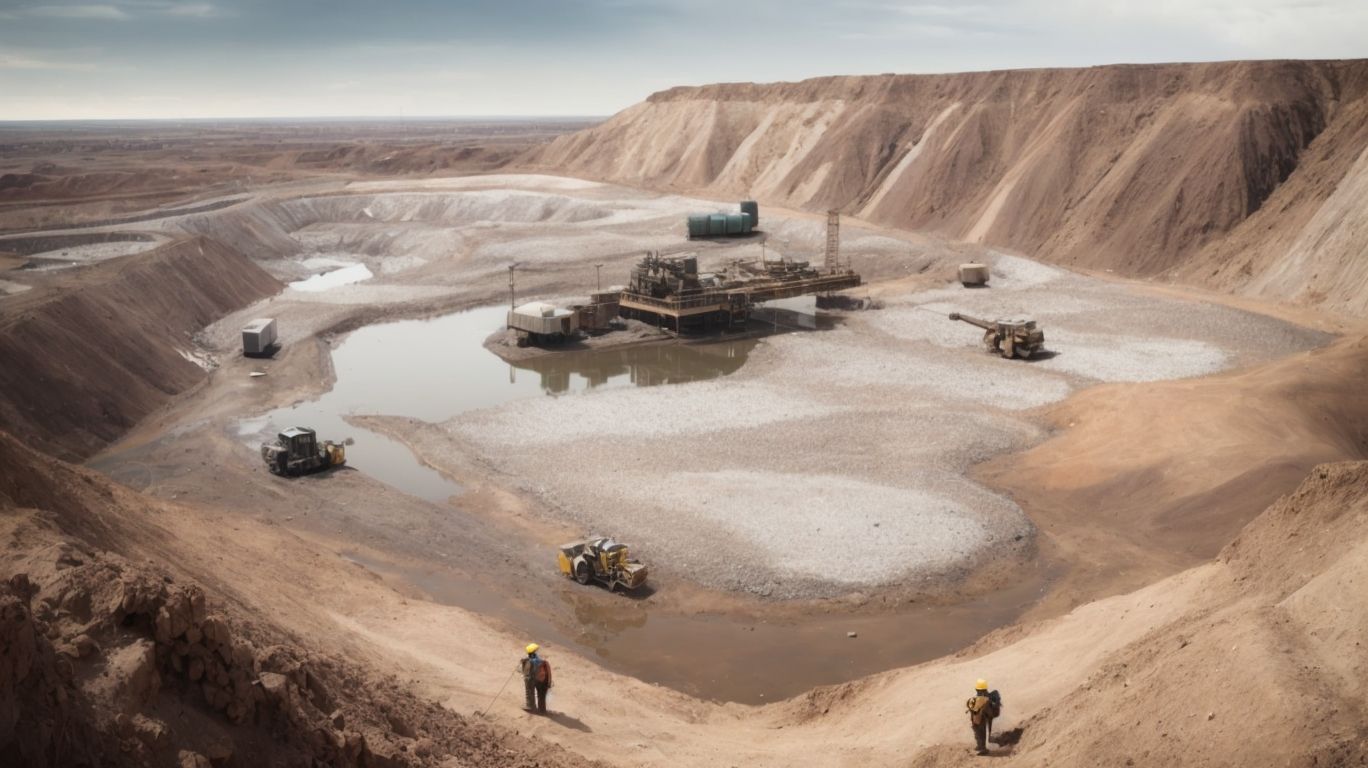
Gemstone Mining Unveiled: Techniques, Locations, and Insights
Gemstone mining involves various techniques and locations around the world. Methods range from open-pit mining to underground mining, each with its own differences. Africa, South America, and Asia are top locations for gemstone mining. We delve into the most valuable gemstones and the environmental impacts of mining them. Explore the world of gemstone mining with us and learn how to make it more sustainable.
What Is Gemstone Mining?
Gemstone mining involves the extraction of precious stones and minerals from the earth’s crust through various techniques and processes.
These gemstones hold immense value and significance due to their rarity, beauty, and metaphysical properties. Miners play a crucial role in the gemstone industry as they meticulously search for gemstone deposits in mines or alluvial areas. The exploration process includes identifying potential mining sites, extracting gemstones, and assessing their quality.
Gemstones are formed deep within the Earth’s crust, undergoing a complex process that can take millions of years. Throughout history, gemstones have been cherished for their ornamental and healing purposes by various cultures worldwide.
What Are The Different Techniques Used In Gemstone Mining?
Various techniques are employed in gemstone mining, utilizing specialized tools and equipment to extract valuable gemstones from the earth.
- These methods range from traditional hand tools like picks, hammers, and chisels to more modern machinery such as drills and explosives for large-scale operations.
- The extraction process involves carefully determining the gemstone-rich areas, either through geological surveys or historical data, before physically breaking and removing the surrounding rock to reveal the precious stones.
Safety measures are crucial in gemstone mining to protect the miners and the environment, with protocols in place for handling explosives, ventilation in underground mines, and proper equipment usage. Regulatory bodies oversee mining operations to ensure compliance with environmental standards and ethical practices, emphasizing the importance of sustainable gemstone sourcing and conservation efforts.
Open-pit Mining
Open-pit mining is a technique commonly used in gemstone extraction, involving the excavation of gemstone deposits from the surface of the earth.
This method is preferred for its efficiency in accessing gemstone deposits located close to the surface, making it cost-effective compared to underground mining. The process of open-pit mining begins with the identification of a viable deposit, followed by the clearing of vegetation and topsoil to expose the gem-bearing rock. Large machinery such as excavators and haul trucks are then utilized to extract the gemstones from the pit. This method allows for increased production rates and facilitates the recovery of gemstones of varying quality, which are later sorted and graded based on their characteristics.
Underground Mining
Underground mining is a method employed in gemstone extraction to access deeper mineral deposits beneath the earth’s surface through specialized excavation techniques.
These sophisticated methods are crucial in the gemstone industry as they allow miners to extract precious stones that are typically found at deeper levels, where geological conditions vary significantly. The authentication and certification process in underground mining are essential steps to ensure the quality and authenticity of gemstones.
Gemstones are meticulously graded based on a set of industry standards to determine their rarity and value, with factors such as color, clarity, cut, and carat weight playing a key role in their evaluation.
Alluvial Mining
Alluvial mining is a technique utilized in gemstone extraction that involves the excavation of minerals from riverbeds and sediment deposits found in various geographical regions.
These riverbed deposits hold a significant geological significance as they have been subjected to the forces of nature, resulting in the concentration of gemstones over time.
The evaluation of gemstone characteristics in alluvial mining is crucial, as gemstones found in these deposits may exhibit unique qualities shaped by their environment. Rarity considerations play a key role in determining the value of extracted gemstones, with factors such as color, clarity, and size contributing to their desirability in the market.
Gemstone experts employ various methods to assess the value of these gemstones, taking into account their quality and rarity to determine their worth.”
Where Are The Best Locations For Gemstone Mining?
Gemstone mining thrives in various regions worldwide, with significant deposits found in key geographical locations known for their diverse gemstone quality, color variations, and clarity.
These prime locations often boast a rich variety of gemstone types, each with distinct characteristics that appeal to collectors and buyers alike. For example, the emerald mines of Colombia are revered for their deep green hue and exceptional clarity, while the sapphire mines in Sri Lanka are famous for their range of colors from cornflower blue to vivid pink. The assessment of gemstone quality involves evaluating factors like carat weight, cut, and origin, which significantly impact pricing dynamics in the market.
Africa
Africa stands out as a prominent region for gemstone mining, offering a rich tapestry of colorful gem varieties distinguished by exceptional clarity, precision cuts, and diverse carat weights.
The exploration ventures into Africa’s gemstone mining landscape unveil a mesmerizing array of hues, from the deep blues of Tanzanite to the vibrant reds of Rubies sourced from Mozambique. Each gemstone boasts unique characteristics, setting them apart in the market.
When it comes to clarity standards, African gemstones often exhibit impressive transparency, attracting both local artisans and international buyers. The cut variations further enhance the allure, with expert craftsmen showcasing intricate designs that maximize the stones’ beauty.
Carat considerations play a crucial role in determining the value and rarity of these gems, influencing pricing factors in the competitive gemstone market.
South America
South America boasts a diverse gemstone mining landscape, characterized by exceptional quality standards, detailed gemstone evaluations, distinctive characteristics, varied shapes, carat considerations, and pricing dynamics.
Exploration activities in this region are intensive, with miners scouring various terrains for precious stones like emeralds, amethysts, and topaz. Quality assessment processes involve thorough inspections to guarantee authenticity and value. Gemstones in South America often exhibit vibrant colors, unique inclusions, and remarkable clarity. Different shapes such as oval, round, and pear are commonly found, influencing the final pricing based on rarity and size. Carat variations play a crucial role, with larger stones commanding higher prices due to their scarcity and desirability.
Asia
Asia emerges as a significant hub for gemstone mining activities, showcasing diverse gemstone formation processes, unique characteristics, distinctive inclusions, varied shapes, enhancement techniques, and manufacturing practices.
The exploration endeavors in Asia delve deep into the rich geological landscapes of the region, uncovering a multitude of gemstone varieties. Gemstones are formed through a complex interplay of geological forces like heat, pressure, and chemical reactions over millions of years, resulting in their exquisite beauty.
Gemologists meticulously study the inclusions within gemstones to identify their origin and enhance their value. The shapes of gemstones in Asia range from classic cuts to more unconventional designs, reflecting the creativity and innovation prevalent in the manufacturing sector.
Australia
Australia holds a prominent position in the gemstone mining sector, renowned for its exceptional gem quality, detailed evaluations, distinct characteristics, unique properties, lapidary practices, and advanced cleaning methodologies.
Gemstone exploration ventures in Australia are supported by cutting-edge technologies and extensive geological surveys that aid in identifying potential mining sites. The quality assessment procedures involve rigorous testing to ensure that only the finest gemstones are extracted. Characteristics such as color, clarity, and carat weight play crucial roles in determining the value of these precious stones. The distinctive properties of Australian gemstones, like opals, sapphires, and diamonds, contribute to their allure in the global market.
North America
North America stands as a pivotal region in the gemstone mining domain, characterized by rare gemstone occurrences, trendsetting dynamics, significant value propositions, versatile usage applications, demand fluctuations, and expert appraisal practices.
Exploration initiatives in this region play a crucial role in uncovering new gemstone deposits and evaluating their rarity. Geologists and mining companies are constantly engaged in prospecting activities to identify potential sources of valuable gemstones. The assessments of rarity in North America are conducted meticulously, considering factors like geological conditions, mineral composition, and historical mining data. Trend forecasts are driven by a combination of market research, consumer preferences, and fashion trends, shaping the direction of gemstone extraction and trading in the region.
What Are The Most Valuable Gemstones?
Several gemstones are highly valued in the market due to their rarity, exceptional quality, and significant monetary worth, including diamonds, emeralds, rubies, sapphires, and opals.
Among these gemstones, diamonds stand out as one of the most coveted due to their unrivaled hardness, brilliance, and timeless allure. Known as the hardest natural substance on Earth, diamonds symbolize enduring love and strength, making them a popular choice for engagement rings and other symbolic jewelry. The value of diamonds is determined by the 4Cs: carat weight, cut, color, and clarity, with flawless stones fetching the highest prices in the market. Colored diamonds like pink, blue, and yellow are incredibly rare and highly sought after by collectors and connoisseurs alike.
Diamond
Diamonds hold a premier status among gemstones, prized for their rarity, exceptional value, superior quality, precise grading standards, substantial reserves, and remarkable discovery tales.
These magnificent gemstones are meticulously evaluated for their rarity using stringent assessments that consider factors like carat weight, color, clarity, and cut. The determination of a diamond’s value involves intricate processes that involve market demand, the 4 Cs (carat, cut, color, clarity), and prevailing economic trends.
Quality criteria for diamonds encompass attributes such as brilliance, fire, and scintillation, which are crucial in determining the overall beauty of a stone. Grading methodologies, including GIA and AGS certifications, play a pivotal role in standardizing the diamond industry and ensuring transparency.
Reserve estimations rely on geological surveys, exploration data, and advanced technology to assess the potential yield of diamond mines globally, shaping the industry’s future prospects. The captivating narratives of diamond discoveries, from the famed Cullinan diamond to the recent unearthings in Botswana and Russia, continue to fascinate and inspire enthusiasts worldwide.
Emerald
Emeralds stand out as prized gemstones renowned for their rarity, substantial value, exceptional quality standards, detailed evaluations, and precise grading systems.
These luxurious gemstones, particularly valued for their vivid green hues and captivating allure, often come from regions like Colombia, Zambia, and Brazil. The rarity of emeralds is influenced by factors such as color intensity, clarity, and size.
Gemologists meticulously assess emerald value based on the 4Cs – color, cut, clarity, and carat weight. The assessment also involves considering additional factors like origin, treatment history, and presence of any inclusions. These exacting evaluations and grading criteria ensure that each emerald is rated and priced according to its unique characteristics.
Ruby
Rubies symbolize elegance and allure as coveted gemstones esteemed for their rarity, substantial value propositions, exceptional quality benchmarks, authentication processes, and stringent certification standards.
These precious gems, with their deep red hue and rich history, are highly sought after in the world of jewelry and gemstone enthusiasts. The assessment of a ruby’s rarity involves factors such as its color intensity, clarity, size, and origin. Value determinations take into account market demand, historical significance, and the gem’s individual characteristics. Quality standards for rubies encompass the 4 Cs (color, cut, clarity, and carat weight) similar to other gemstones, ensuring that each stone meets specific criteria for beauty and brilliance.
Sapphire
Sapphires exude sophistication and charm as sought-after gemstones valued for their rarity, significant monetary worth, superior quality attributes, diverse sources, investment potential, and expert appraisal practices.
Within the realm of sapphire mining, the evaluation of rarity holds immense importance in determining the value of these precious gemstones. The scarcity of certain sapphire colors, such as the highly coveted Kashmir blue sapphires or the rare Padparadscha sapphires, greatly impacts their market desirability and price points. Gemologists meticulously assess sapphire quality based on criteria like color saturation, clarity, cut precision, and carat weight. Understanding the varying sources of sapphires, from Sri Lanka to Australia, allows investors to diversify their portfolios with these enduring assets.
Opal
Opals radiate beauty and mystique as prized gemstones valued for their rarity, substantial worth, exceptional quality features, unique characteristics, market demand dynamics, and expert appraisal processes.
Their rarity is a key factor that influences their value, with assessments often taking into account factors such as color play, transparency, pattern formation, and overall brilliance.
Opals are cherished for their mesmerizing display of iridescence, known as ‘play-of-color,’ which adds to their allure and market appeal.
The fluctuating demand for opals can be influenced by trends in the jewelry industry, cultural preferences, and even fashion cycles, leading to varying price points for these captivating gemstones.
What Are The Environmental Impacts Of Gemstone Mining?
Gemstone mining operations have notable environmental impacts, contributing to concerns such as deforestation, soil erosion, water pollution, and loss of biodiversity in mining areas.
These activities not only lead to habitat destruction for wildlife but also have significant effects on the delicate ecosystem balance within these regions. The process of clearing land for mining disrupts natural habitats, displacing flora and fauna, which can have cascading effects on the entire ecosystem.
The excavation and processing of gemstones often result in chemical runoff and sedimentation, leading to water pollution and degradation of water quality in surrounding areas.
Deforestation
Deforestation is a critical environmental concern linked to gemstone mining activities, impacting various geographical regions and necessitating sustainable conservation and preservation efforts in the gemstone supply chain.
- The continuous clearance of trees for gemstone extraction not only diminishes vital ecosystems but also contributes to soil erosion, water pollution, and loss of biodiversity. Addressing these challenges requires collaboration among stakeholders to implement responsible mining practices.
- Initiatives promoting reforestation and sustainable land management play a crucial role in mitigating the adverse effects of deforestation in gemstone mining. By integrating eco-friendly technologies and supporting local communities, the industry can strive towards a more environmentally conscious and socially responsible approach to gemstone sourcing.
Soil Erosion
Soil erosion poses a significant environmental challenge associated with gemstone mining, warranting sustainable practices, market analysis insights, conservation efforts, and ethical research considerations.
The process of extracting gemstones can often result in soil degradation due to improper mining techniques, affecting the surrounding ecosystem. Sustainable mining practices are crucial to mitigate these detrimental effects.
Market analysis becomes imperative in understanding the demand-supply dynamics of gemstones, influencing mining activities. Conservation strategies, such as reforestation and terracing, play a vital role in restoring soil health and preventing erosion.
Ethical research dimensions focus on the responsible sourcing of gemstones, supporting communities and safeguarding natural habitats in the mining areas.
Water Pollution
Water pollution emerges as a critical environmental consequence of gemstone mining activities, necessitating sustainable manufacturing practices, market analysis considerations, grading protocols, and inclusion assessments for mitigation.
This pressing issue stems from the discharge of toxic chemicals and sediment into water bodies during various stages of the mining process. In order to address this challenge, industry stakeholders are increasingly focusing on employing eco-friendly extraction methods, stricter water usage guidelines, and innovative filtration techniques. By integrating improved manufacturing standards and thorough market analysis insights, the industry aims to enhance sustainability practices and reduce the negative impact on water quality caused by gemstone mining operations.
Emphasizing comprehensive grading procedures and inclusion evaluations can lead to a more responsible sourcing approach, thereby contributing to the broader goal of minimizing water pollution in the gemstone mining sector.
Loss Of Biodiversity
The loss of biodiversity is a pressing environmental issue stemming from gemstone mining activities, necessitating sustainable discovery practices, source evaluations, enhancement considerations, and conservation efforts to safeguard ecological diversity.
This depletion in biodiversity is largely due to the extensive land clearing, ecosystem disruption, and pollution from mining operations. Sustainable mining practices involving proper land reclamation, reduced environmental impact assessments, and employing eco-friendly methodologies are crucial in mitigating this negative impact.
Conducting thorough evaluations of gemstone sources ensures responsible sourcing and prevents environmental degradation. Implementing enhancement practices like reforestation programs and wildlife conservation initiatives can help restore and preserve ecosystems affected by mining activities, promoting overall biodiversity conservation.
How Can Gemstone Mining Be More Sustainable?
Achieving sustainability in gemstone mining requires adherence to stringent regulations, ethical practices, conservation initiatives, preservation strategies, research advancements, and educational efforts to mitigate environmental impacts.
By implementing measures such as reduced chemical use, proper waste management, and restoration of mined areas, sustainable gemstone mining practices can contribute to the overall well-being of ecosystems.
The integration of cutting-edge technologies like drone surveys and remote sensing helps in monitoring and managing mining activities with minimal disruption to the environment.
Educational programs focused on community involvement and raising awareness about the importance of sustainable mining are essential for fostering a culture of responsible gemstone extraction in the industry.




No Comments